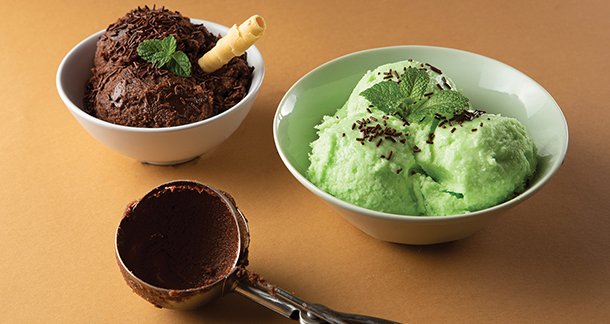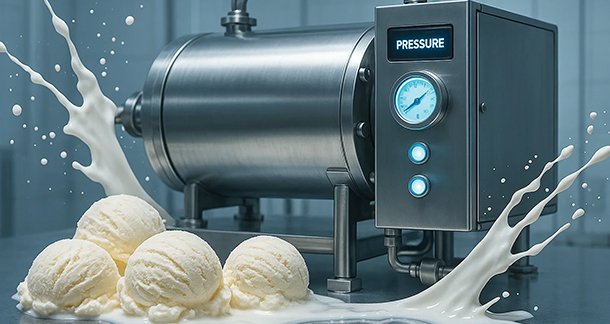Abstract
High pressure processing (HPP) is reshaping how the dairy industry approaches ice cream mix preparation, offering a non-thermal, clean label method that improves texture, safety, and shelf life. The technology applies intense isostatic pressure typically up to 600 MPa to pre-packaged or bulk food, enabling unique modifications to product structure and microbiological safety while preserving nutritional and sensory qualities.
Introduction
HPP uses hydrostatic pressure uniformly transmitted by chilled water, impacting dairy proteins and fat globules without the adverse effects of heat. This preserves flavors and nutrients that are often degraded in thermal processing. For ice cream mixes, HPP can be applied between 200 and 600 MPa for as little as one second, with changes in casein micelle structure and water-binding ability at the core of its functional benefits. Scientific findings emphasize how HPP fragments casein micelles, reassembling them into a dense protein network on decompression, thereby increasing mix viscosity. Such protein reorganization occurs at pressures above 400 MPa and even short treatment times can create observable changes in mix viscosity, meltdown resistance, and creaminess. HPP can also enhance the foaming and emulsification contributions of whey proteins when incorporated into low-fat ice cream, increasing overrun (air incorporation) and stability while achieving a smoother, creamier texture even with reduced fat or additives In ice cream, HPP’s primary advantage is texture enhancement: products show increased resistance to melting, better mouthfeel, and a softer, creamier sensation. Studies reveal that ice cream mixes treated at 400-500 MPa, even for just one second, become notably more viscous, requiring less reliance on added stabilizers or emulsifiers. This facilitates the production of low-fat or stabilizer-free ice creams that still maintain consumer-preferred body and mouthfeel. The pressure-induced network formation among milk proteins can also contribute to a slower meltdown, firmer body, and smoother product consistency. Beyond sensory characteristics, HPP is extremely effective at reducing pathogenic and spoilage microorganisms in dairy, including in high-water-activity products like cream. Research shows that treatment at 450 or 600 MPa for as little as 5 to 15 minutes can render cream and ice cream mixes microbiologically safe for at least 15 to 51 days longer than conventional pasteurization. This reduces reliance on chemical preservatives and fits demand for “clean label” ingredients, and it adds considerable value to logistics and supply chain management.

Benefits:
HPP not only affects proteins but also alters fat crystallization, accelerating the desired solid fat content and reducing required aging time in the mix. The technique can depress the freezing point of water (e.g., to -22°C at 210 MPa), allowing sub-zero food processing without damaging ice crystal formation a key benefit for texture retention in premium frozen desserts. Foaming and overrun are also enhanced, as the pressure changes in protein structure lend better air-holding capacity. Studies and commercial trials demonstrate HPP’s feasibility for both packaged and bulk processing, and the capital expenditure for equipment is increasingly offset by ingredient savings, shelf life extension, marketing opportunities, and reduced wastage. HPP-treated ice cream mixes can be used immediately or stored for longer, improving manufacturing efficiency and flexibility.
- The adoption of HPP in the ice cream sector parallels rising global interest in natural, sustainable, minimally processed food.
- HPP dramatically increases the viscosity of ice cream mixes, resulting in thicker, creamier products, even when fat and protein content are reduced.
- The process enables a smoother, softer texture and higher resistance to melting, providing a more enjoyable consumer experience.
- By disrupting casein micelles and fostering a proteinaceous network, HPP mimics and even surpasses the effects of conventional stabilizers and emulsifiers meaning manufacturers can reduce or eliminate these ingredients without sacrificing quality.
- HPP preserves natural flavors, vitamins, and other sensitive nutrients far better than traditional thermal pasteurization, providing a more “natural” tasting and nutritionally intact product.
- HPP is commercially scalable industrial equipment is widely available and suitable for both in-pack and bulk processing, giving manufacturers flexibility in how they integrate the technology

Conclusion
High pressure processing is forging a path for cleaner, more natural, and higher-quality ice cream production. It enables substantial reductions in fat and additives, provides robust safety margins, improves product consistency, and aligns with contemporary consumer expectations. Continued research into pressure-protein interactions and commercial scalability suggests HPP will become a standard in the next generation of ice cream innovation.
About Author
Gargi Sharma1 and Anshika Gupta2
1,2Department of Biotechnology
Gautam Buddha University, Greater Noida (UP-201312)
Corresponding author email: ruchiverma0715@gmail.com
REFRENCES
- Ganesan, et al. “High-Pressure Processing and its Impact on Dairy Products.” Food Science and Technology: An International Journal (FSTJ) 1.1 (2016): 30-47.
- Huppertz, T. et al. “Effects of high pressure treatment of mix on ice cream mix and ice cream.” International Dairy Journal 21.12 (2011): 896-902.
- Machado, F., et al. “High Pressure and Pasteurization Effects on Dairy Cream.” Foods. 2023 Sep; 12(19): 3765.
- Siddiqui, S. A., et al. “Impact of high-pressure processing on thebioactive and functional properties of milk and dairy products.” Foods. 2024 Mar; 13(6): 1035.
- Dhineshkumar, V., et al. “High pressure processing technology in dairy processing.” Asian Journal of Dairy and Food Research



